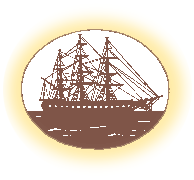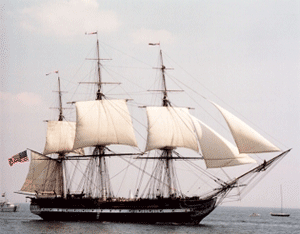
 |
 |

| Getting Started Key Words & Concepts Glossary Activities Recommended Resources Scuttlebutt | ||||
| Getting Started Ask students if they have ever slid down a hill or a bannister and gotten stuck part way down. Constitution did. On September 20, 1797, after sliding 27 feet down the ways, or ramp to the water, she stopped. And there she sat, stranded in front of a crowd of dignitaries, including President John Adams, who were watching from a viewing platform, eagerly anticipating a night of celebration to commemorate her successful launch into the waters of Boston Harbor. What went wrong? |  | |||
Key Words and Concepts
You might ask the class what can happen when you do something for the first time. In 1794, Congress had approved building frigates that would be larger than any ships ever constructed in America. In the spring before Constitution was launched, USS United States was damaged during her launch in Philadelphia when she slid into the water too fast. She had to be hauled out for repairs. Ask the class what Constitution's builders did to make sure she did not have the same problem. They reduced the incline by reducing the angle of the ways making it less steep. So what did they have to do to get her moving after she got stuck? Increase the angle of the ways, but not too much.
Finding the right angle took two more tries, a good example of the scientific method of trial and error. Just after noon, on October 21, 1797, Constitution finally reached her destined element, as the local press noted. To christen her, a bottle of Madeira wine was broken on her bowsprit.
HARNESSING THE WIND
When she entered the water, Constitution was no more than a hull without masts or rigging. The next task was to rig and outfit her. What did she need to make her fast and powerful enough to win the battles that lay ahead? Ask students what, besides hull design, makes a sailing ship fast. Lots of sail.
 |
Constitution had more than 40* sails, more than other frigates of her day. When she set, or put on, every stitch of canvas, the area of her sails totaled almost an acre, the unit of measure commonly used for land. To help students grasp this size, compare it
to something familiar, for example, five times the size of a baseball diamond. Her largest sail was the size of a regulation basketball court! If you plan to have students do the Room to Unfurl activity, write on the board the measurements of your classroom that were computed for Lesson 2. You might also ask a volunteer to show the class how to compute area in square feet and convert to square yards. Extend the activity sheet by asking students to do this conversion for some of the questions.
Use a drawing of Constitution on the page below to create a rough sketch on the board. Ask students to name the parts of the ship that held the sails (the masts, the yards, or cross pieces on the masts, and the bowsprit).
Ask for a student volunteer to find the tallest mast and write its name — mainmast — on the board. Explain that the front of the ship is called the bow and the back, the stern. Then have another volunteer label the foremast near the bow, and the mizzenmast near the stern.
See if the class can guess which of the sails made Constitution unique. The highest sails on many ships were the topgallants. Constitution had royals above her topgallants, and later she had even higher sails called skysails. Lower down, were the sails simply named after the mast they were on: mainsail and foresail, on the mainmast and foremast, respectively, with topsails just above these. On the mizzenmast, a topsail was below the topgallant.
Tell students that besides adding sails to the top of the masts, there is yet another way to increase sail on a ship. Constitution had sails called studding sails, also called “stunsails,” that extended out over her sides. Finally, she had a set of sails called staysails to help her keep her course.
To manipulate the sails, Constitution has about 257 lines of rope called running rigging. Some of these lines run through blocks, or pulleys, on the yards so that the sails can be raised and lowered. There is also standing rigging to hold the masts firmly in place and carry the staysails. Altogether, her standing and running rigging stretch out for miles!
*The number of sails on Constitution changed over her life time. Thirty-six is used by experts today as the number of her sails.
- bowsprit: a spar that extends forward off the bow of a ship
- rigging: ropes, and later, wires or chains used on ships to support the masts and adjust sails
- outfit: to equip with sails, rigging, armaments and other necessary hardware
- yards: wooden crosspieces on the masts that hold the sails
| K-4
5-8
9-12
|
 |